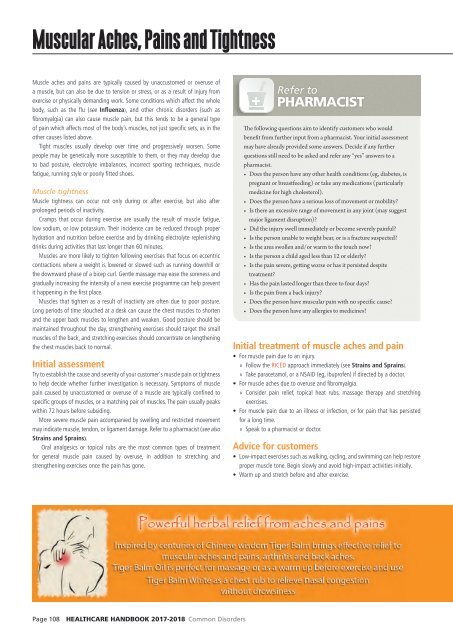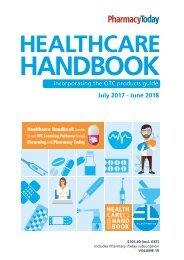2017 HCHB_digital
You also want an ePaper? Increase the reach of your titles
YUMPU automatically turns print PDFs into web optimized ePapers that Google loves.
Muscular Aches, Pains and Tightness<br />
Muscle aches and pains are typically caused by unaccustomed or overuse of<br />
a muscle, but can also be due to tension or stress, or as a result of injury from<br />
exercise or physically demanding work. Some conditions which affect the whole<br />
body, such as the flu (see Influenza), and other chronic disorders (such as<br />
fibromyalgia) can also cause muscle pain, but this tends to be a general type<br />
of pain which affects most of the body’s muscles, not just specific sets, as in the<br />
other causes listed above.<br />
Tight muscles usually develop over time and progressively worsen. Some<br />
people may be genetically more susceptible to them, or they may develop due<br />
to bad posture, electrolyte imbalances, incorrect sporting techniques, muscle<br />
fatigue, running style or poorly fitted shoes.<br />
Muscle tightness<br />
Muscle tightness can occur not only during or after exercise, but also after<br />
prolonged periods of inactivity.<br />
Cramps that occur during exercise are usually the result of muscle fatigue,<br />
low sodium, or low potassium. Their incidence can be reduced through proper<br />
hydration and nutrition before exercise and by drinking electrolyte replenishing<br />
drinks during activities that last longer than 60 minutes.<br />
Muscles are more likely to tighten following exercises that focus on eccentric<br />
contractions where a weight is lowered or slowed such as running downhill or<br />
the downward phase of a bicep curl. Gentle massage may ease the soreness and<br />
gradually increasing the intensity of a new exercise programme can help prevent<br />
it happening in the first place.<br />
Muscles that tighten as a result of inactivity are often due to poor posture.<br />
Long periods of time slouched at a desk can cause the chest muscles to shorten<br />
and the upper back muscles to lengthen and weaken. Good posture should be<br />
maintained throughout the day, strengthening exercises should target the small<br />
muscles of the back, and stretching exercises should concentrate on lengthening<br />
the chest muscles back to normal.<br />
Initial assessment<br />
Try to establish the cause and severity of your customer's muscle pain or tightness<br />
to help decide whether further investigation is necessary. Symptoms of muscle<br />
pain caused by unaccustomed or overuse of a muscle are typically confined to<br />
specific groups of muscles, or a matching pair of muscles. The pain usually peaks<br />
within 72 hours before subsiding.<br />
More severe muscle pain accompanied by swelling and restricted movement<br />
may indicate muscle, tendon, or ligament damage. Refer to a pharmacist (see also<br />
Strains and Sprains).<br />
Oral analgesics or topical rubs are the most common types of treatment<br />
for general muscle pain caused by overuse, in addition to stretching and<br />
strengthening exercises once the pain has gone.<br />
Refer to<br />
PHARMACIST<br />
The following questions aim to identify customers who would<br />
benefit from further input from a pharmacist. Your initial assessment<br />
may have already provided some answers. Decide if any further<br />
questions still need to be asked and refer any “yes” answers to a<br />
pharmacist.<br />
• Does the person have any other health conditions (eg, diabetes, is<br />
pregnant or breastfeeding) or take any medications (particularly<br />
medicine for high cholesterol).<br />
• Does the person have a serious loss of movement or mobility?<br />
• Is there an excessive range of movement in any joint (may suggest<br />
major ligament disruption)?<br />
• Did the injury swell immediately or become severely painful?<br />
• Is the person unable to weight bear, or is a fracture suspected?<br />
• Is the area swollen and/or warm to the touch now?<br />
• Is the person a child aged less than 12 or elderly?<br />
• Is the pain severe, getting worse or has it persisted despite<br />
treatment?<br />
• Has the pain lasted longer than three to four days?<br />
• Is the pain from a back injury?<br />
• Does the person have muscular pain with no specific cause?<br />
• Does the person have any allergies to medicines?<br />
Initial treatment of muscle aches and pain<br />
• For muscle pain due to an injury.<br />
»»<br />
Follow the RICED approach immediately (see Strains and Sprains).<br />
»»<br />
Take paracetamol, or a NSAID (eg, ibuprofen) if directed by a doctor.<br />
• For muscle aches due to overuse and fibromyalgia.<br />
»»<br />
Consider pain relief, topical heat rubs, massage therapy and stretching<br />
exercises.<br />
• For muscle pain due to an illness or infection, or for pain that has persisted<br />
for a long time.<br />
»»<br />
Speak to a pharmacist or doctor.<br />
Advice for customers<br />
• Low-impact exercises such as walking, cycling, and swimming can help restore<br />
proper muscle tone. Begin slowly and avoid high-impact activities initially.<br />
• Warm up and stretch before and after exercise.<br />
Page 108 HEALTHCARE HANDBOOK <strong>2017</strong>-2018 Common Disorders



